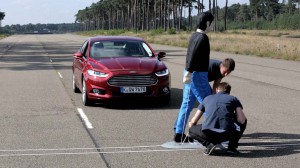Ford Motor Co. will launch a new collision warning system that it says “may” prevent the pedestrian crashes that have become a growing problem on U.S. roads.
While overall highway fatalities have been on a sharp decline in recent years, the number of pedestrians killed in motor vehicle crashes actually has been on the increase over the last half decade, reaching more than 4,700 annual fatalities, according to federal data — and about one death every two minutes worldwide.
Ford’s new pedestrian alert technology is part of an upgrade to the collision avoidance system it first introduced in 2009, and will be renamed “pre-collision assist with pedestrian detection.” It will first debut on the 2015 Ford Mondeo about to go on sale in Europe, but Ford plans to expand its use to other models, including those sold in the States – where a version of the Mondeo is sold as the midsize Fusion sedan.
A number of other automakers, including Volvo and Mercedes-Benz, have been adding technology designed to reduce collisions with pedestrians, bicyclists, and even with animals.
(NHTSA chief Friedman apologies for blunders in Takata airbag recall alert. Click Here for the story.)
Ford says it used both virtual and real world tests to develop the new pedestrian detection system. Rather than risking a human guinea pig, however, it relied on specially fitted manikins who were meant to replicate a pedestrian crossing a closed test track. The challenge was both to minimize false alarms while ensuring real situations aren’t missed.
“This real-world testing was an important part of the development, because pedestrians in an urban setting can present a wide range of potential situations,” said Scott Lindstrom, Ford manager, Driver Assist Technologies. “We covered more than 300,000 miles on three continents that included a wide range of settings and situations.”
(Click Here for the latest on the Takata airbag recall which now covers 7.8 million vehicles.)
The Ford system adds a camera mounted above the rearview mirror to the radar and other sensors already used in the current collision warning system. That makes it easier to distinguish, say, a pedestrian from a telephone pole.
If a potential collision is detected, whether with a car or person on foot, the vehicle sounds an alert and flashes a red warning light visible on the windshield. If the driver doesn’t respond immediately, the system pre-charges the brakes so they will respond more aggressively once the brake pedal is applied.
If the motorist continues to ignore the situation, the vehicle will begin to brake automatically, at least to reduce the severity of an impact, if it can’t prevent one.
Ford is cautious to say the system “may help drivers” avoid a crash. The system won’t work optimally under certain lighting and weather conditions, or at night, when visibility is reduced. But even so, the potential benefit could be substantial.
According to the Centers for Disease Control, 4,743 pedestrians were killed in the U.S. in 2012, the latest year for which complete data are available, a more than 6% year-over-year increase. Globally, the problem is equally severe. In fact, over a third of all highway deaths in lower- and middle-income countries, the World Health Organization reported.
Ford is just one of many automakers who have added a vehicle collision avoidance system to its vehicles. In fact, one is now a requirement to earn a Top Safety Pick+ rating from the Insurance Institute for Highway Safety.
But systems that can spot a pedestrian, as well as another vehicle, are still relatively rare. Ford’s former Swedish subsidiary, Volvo, was the first to add the feature as an enhancement to its City Safety collision avoidance system.
One of the most advanced versions was introduced on the 2014 Mercedes-Benz S-Class. The flagship sedan not only can detect a pedestrian or larger animal in the road, but at night it will flash a warning light at a human to alert them of the oncoming vehicle. The S-Class also is one of several vehicles equipped with infrared night vision that can help the driver spot humans and animals lurking ahead on dark roads and take evasive action.
Such technologies are expected to become commonplace in the decades ahead as the industry begins to roll out semi- and fully autonomous vehicles.
(Mini mis-labeled, must correct, fuel economy stickers. Click Here for the story.)


“[T]he number of pedestrians killed in motor vehicle crashes actually has been on the increase over the last half decade, reaching more than 4,700 annual fatalities, according to federal data, or about one death every two minutes.”
Is that the kind of math they teach you at Brookdale Community College?
Correct, I inadvertently confabulated global and US numbers. We’ll correct.
4700 fatalities per year is equal to one death every 110 minutes, not every 2 minutes.
Please do the math.
An omission of a critical detail on my part…now corrected. The 2 minute figure is worldwide.
Paul E.
I’m not so sure that pedestrians who wander out into traffic should be saved. Maybe that is really intended to be the Darwinian population control mechanism?